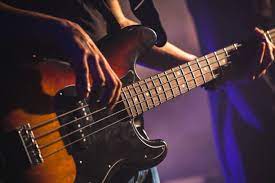What are bass guitar arpeggios? How are they different from other types of arpeggios? And how can you start using them in your own playing? In this article, we’ll answer all those questions and more.
You’ll learn what bass guitar arpeggios are, how to create your own, and how to play them in a variety of ways. So whether you’re a beginner or an experienced player, there’s something for everyone here!
What is an arpeggio?
An arpeggio is a musical technique where notes in a chord are played in succession, rather than simultaneously.
It is a common tool used by composers and performers to add interest and complex harmonies to their pieces.
Arpeggios can be played on any instrument, but are particularly effective on string instruments such as guitars and violins.
When playing an arpeggio, each note of the chord is sounded one after the other, giving the music a flowing, cascading sound.
This technique can be used to create simple melodies or elaborate embellishments, depending on the skills of the performer.
With practice, arpeggios can become an essential part of any musician’s repertoire.
Major Arpeggio Construction
Building a major arpeggio is exactly the same as building a major triad.
First, you must find your root note. Let’s use C for this example.
Next, you need to go up a major third (or four semitones) from your root note and add that note to your chord.
From C this gives you the note of E. This is also known as the major third.
From E, go up a minor third (three semitones) which gives you G. This is the perfect 5th.
Collect the root note, major third and perfect fifth together and you’ll have C, E and G which is a C major triad.
To make it an arpeggio simply play the notes in sequence one after the other.
The 7 Arpeggios from C Major: Exercises
You can build arpeggios from each degree of the major scale by following this method.
The C major scale has the notes C, D, E, F, G, A, B and C.
If you take each note of the scale as a possible root note, you can build an arpeggio from each by starting on a root note (let’s say D for example), skipping the next note (E), adding the note after that to your arpeggio (F), skipping the next note (G) and finally adding the note after that (A).
This gives us D, F and A.
Next, you must understand which type or arpeggio you have.
It will be one of the four main types which are major, minor, diminished and augmented.
The arpeggio above is D minor.
With major scales in any key the order of arpeggios is always major, minor, minor, major, major, minor and diminished.
Using our example above in C this creates C major, D minor, E minor, F major, G major, A minor and B diminished.
C Major on a single string
A really good way to learn to combine arpeggio practice with learning the neck (which I have talked about in recent posts) is to learn arpeggios up and down one string as well as in positions on the neck.
Doing this will help you understand what the notes of each arpeggio are, where they are on the neck and how these notes can be played in a multitude of different ways on the neck of the bass.
6 Bass Arpeggio Exercises for Your Practice Routine
Check out these videos for some ideas to add arpeggios to your practice routine.
FAQ’s
How do you use bass arpeggios?
Common uses for bass arpeggios are for riffs, hooks, melodies and in walking bass lines.
What is an Arpeggiation?
Arpeggiation is taking the notes of a chord and playing them one by one in a sequence.
What is a bass triad?
A bass triad (the same as a triad on any other instrument) consists of three notes, the root, the third, and the fifth. The root is the lowest note, the third is in the middle, and the fifth is the highest.
The triad can be played in any order, but the most common order is root-third-fifth. The interval between the root and the third is called a minor third, while the interval between the third and the fifth is called a major third.
What is a bass guitar arpeggio?
Bass arpeggios are a series of notes that are played in succession. The most common type of arpeggio is the triad, which consists of three notes played in quick succession.
Bass guitarists often use arpeggios to create a sense of movement in their playing.
By playing a series of notes in quick succession, they can create a flowing, waterfall-like sound.
Arpeggios can also be used to add tension and release to a bassline. By starting on the root note and then moving up the scale, bassists can create a sense of anticipation that is released when they reach the higher note.
Bass guitar arpeggios are a versatile tool that can be used to add interest and texture
How do you play arpeggios on a bass guitar?
By memorizing common patterns and arpeggio shapes on the bass neck.
How do you memorize arpeggio shapes on bass guitar?
There is no definitive answer to this question. One way to memorize bass guitar arpeggios is to practice playing them in different positions on the neck, as well as up and down one bass string.
Another approach is to learn each arpeggio in all 12 keys. This can be a bit of a daunting task, but it will give you a strong understanding of how the arpeggios work in any key.
Once you have learned the shapes, you can then begin to practice playing them in different combinations. This will help you to develop your own bass guitar arpeggio vocabulary.


Leave a Reply